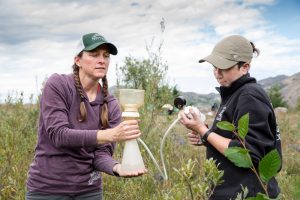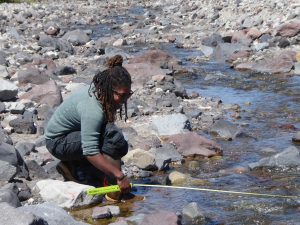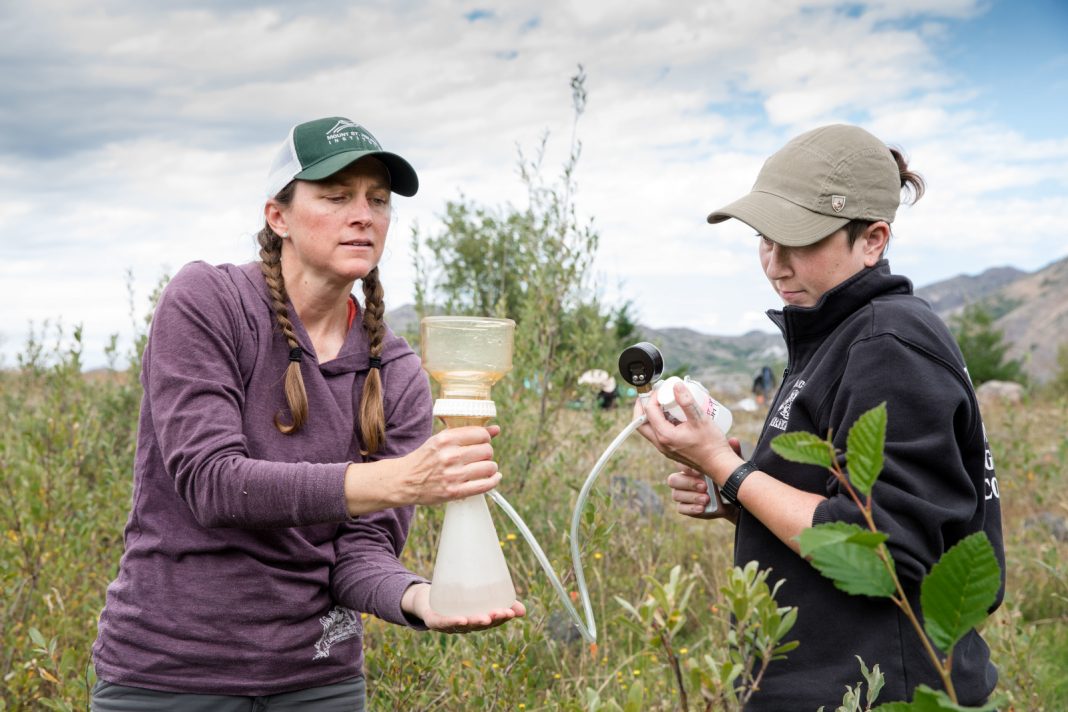Submitted by The Evergreen State College
Forty years ago, Mount St. Helens turned itself inside out, stunning the world with an eruption whose ash would circle the globe. After the violent explosion, the rich, complex ecosystem to the North of the mountain was buried beneath 300 feet of rocky pyroclastic flows. The area now known as the Pumice Plain was transformed into a sterile moonscape after the 1980 eruption. Nothing survived the devastation.

There are many ways that life first returned to the Pumice Plain on Mount St. Helens. Spiders drifting in on the wind; wandering elk scattering the seeds that clung to their hooves; little algae cells raining down from the clouds to colonize the newly-forming streams. Whatever the case, perhaps one of the most abundant forms of life now scurrying across the shoulders of the mountain is the scientist. Since the eruption, researchers have been digging, collecting, measuring and saying “ah-hah!” all over the Pumice Plain.
One such researcher is Dr. Carri LeRoy, a freshwater ecologist and faculty member at The Evergreen State College. Driven by a desire to understand how this young ecosystem is developing, LeRoy is starting at the source: the water.
“They’re entirely new watersheds, not just streams,” says LeRoy. “We can watch who is growing in the water. Who are the algae and the insects? And where did they come from?” In 2018, LeRoy received a coveted National Science Foundation (NSF) grant to explore the impact of willow tree leaves in the streams that are dutifully carving their way through the Pumice Plain.
She wanted to know why there were more female willow trees growing in close proximity to the streams than male willow trees. To put it simply, what she discovered is that the leaves of female willow trees decompose more slowly in the streams than those of male willow trees, thereby providing a source of nutrients in the stream for longer. There are many more pieces of the puzzle to study, such as the numerous aquatic insects and other vegetation holding these new ecosystems together.
Undergrads are scientists, too

But she isn’t doing this complicated work alone. LeRoy, like many faculty members at Evergreen, is passionate about including her students in her research and encourages them to pursue their own projects. As a blossoming ecosystem, the Pumice Plain is an environment ripe with opportunities for undergraduate students to formulate their own hypotheses and develop their own experiments. And Evergreen provides the perfect structure for that. Thanks to the freedom they have to pursue independent research, students can sometimes even get peer-reviewed scientific papers out the door by the time they graduate—something undergraduates at other colleges rarely experience.
“Undergraduates co-authoring papers can happen at Evergreen a lot more easily. I’ve co-authored with 30 undergraduates in the last 15 years,” says LeRoy. “It’s important because it gives them experience with the entire scientific process. What does it mean to be a scientist? What is the actual work?”
Last summer’s grant from the NSF culminated in a peer-reviewed paper LeRoy co-authored with four of her undergraduate students for the scientific journal Ecosphere. Iris Garthwaite, a student co-author graduating this year, says the opportunity to do this research has been central to her Evergreen experience.
“I’m a really hands-on person,” she says. “To be able to go up to the mountain and then do analysis back at the lab and put our research in the context of the wider scientific conversation is so important as a young scientist.” Garthwaite says having research funded by the NSF on her resume has been extremely helpful in applying to graduate schools. Come fall, she will be attending Northern Arizona University’s graduate program to study cottonwood trees and how they contribute to riparian ecosystems.
Jordan Moffett, who graduated from Evergreen last year, also contributed research to the paper. “I did a lot of editing for that paper. I helped with a lot of the data collection and I did a lot of lab work at Evergreen,” she says. Moffett now has a job with the City of Olympia doing environmental work on stormwater ponds.
“When you involve students in research, it gives them opportunities to try out being a scientist as an undergraduate so they have confidence when they go on to graduate school,” says LeRoy. “They can say to themselves, ‘I can do this. I can formulate hypotheses, design experiments, collect data, analyze the data, interpret the data, and write about it.’ That’s the process of science.”
A student-centered experience

LeRoy says that a very small percent of those who submit proposals for grants to the NSF receive funding. Major research universities with big money backing them may have significant advantages when it comes to receiving grants, but LeRoy says the NSF has had faith in Evergreen. “I think part of it is our track record of involving undergraduates,” she says. “They’re interested in the research and also in how we’re getting the word out about the research.”
LeRoy and her students have been involved in many educational events to talk about their work, including engaging with middle school girls, high school students, and upward bound students. “We think hard about how we communicate this work to the public,” she says.
The research on Mount St. Helens is just one example of the groundbreaking work that takes place through Evergreen’s Summer Undergraduate Research Fellowships (SURF) program. Thanks to SURF, students in any discipline—from mathematics to archaeology or literature—can apply to assist faculty with research projects over the summer. Opportunities for undergraduate students like the Mount St. Helens research can be strong resume builders for graduate school or careers in related fields.
Whether you pursue a SURF fellowship or not, all Evergreen students can undertake independent research as part of the college’s Individual Learning Contract program. The freedom you have to tailor your own education is part of what makes Evergreen a strong choice for self-motivated learners.
Applications for fall quarter at Evergreen are open now. Visit The Evergreen State College website to learn more.

















































